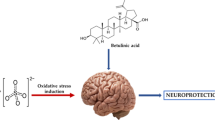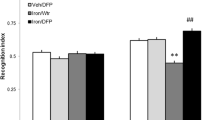Abstract
Several lines of evidence indicate that excess iron may play an etiologically significant role in neurodegenerative disorders. This idea is supported, for example, by experimental studies in animals demonstrating significant neuroprotection by iron chelation. Here, we tested whether this effect might be related to a functional link between iron and the endogenous excitotoxin quinolinic acid (QUIN), a presumed pathogen in several neurological disorders. In particular, the present in vitro study was designed to examine the effects of Fe2+, a known co-factor of oxygenases, on the activity of QUIN’s immediate biosynthetic enzyme, 3-hydroxyanthranilic acid dioxygenase (3HAO), in the brain. In crude tissue homogenate, addition of Fe2+ (2–40 μM) stimulated 3HAO activity 4- to 6-fold in all three species tested (mouse, rat and human). The slope of the iron curve was steepest in rat brain where an increase from 6 to 14 μM resulted in a more than fivefold higher enzyme activity. In all species, the Fe2+-induced increase in 3HAO activity was dose-dependently attenuated by the addition of ferritin, the main iron storage protein in the brain. The effect of iron was also readily prevented by N,N′-bis(2-hydroxybenzyl) ethylenediamine-N,N′-diacetic acid (HBED), a synthetic iron chelator with neuroprotective properties in vivo. All these effects were reproduced using neostriatal tissue obtained postmortem from normal individuals and patients with end-stage Huntington’s disease. Our results suggest that QUIN levels and function in the mammalian brain might be tightly controlled by endogenous iron and proteins that regulate the bioavailability of iron.




Similar content being viewed by others
Abbreviations
- 3HAO:
-
3-hydroxyanthranilic acid dioxygenase
- HBED:
-
N,N′-bis(2-hydroxybenzyl) ethylenediamine-N,N′-diacetic acid
- HD:
-
Huntington’s disease
- QUIN:
-
Quinolinic acid
References
Alberati-Giani D, Ricciardi-Castagnoli P, Köhler C et al (1996) Regulation of the kynurenine metabolic pathway by interferon-gamma in murine cloned macrophages and microglial cells. J Neurochem 66:996–1004
Baraibar MA, Muhoberac BB, Garringer HJ et al (2010) Unraveling of the E-helices and disruption of 4-fold pores are associated with iron mishandling in a mutant ferritin causing neurodegeneration. J Biol Chem 285:1950–1956
Bartzokis G, Lu PH, Tishler TA et al (2007) Myelin breakdown and iron changes in Huntington’s disease: pathogenesis and treatment implications. Neurochem Res 32:1655–1664
Bergeron RJ, Wiegand J, Brittenham GM (1999) HBED: the continuing development of a potential alternative to deferoxamine for iron-chelating therapy. Blood 93:370–375
Bird ED, Iversen LL (1974) Huntington’s chorea. Post-mortem measurement of glutamic acid decarboxylase, choline acetyltransferase and dopamine in basal ganglia. Brain 97:457–472
Block ML, Hong JS (2005) Microglia and inflammation-mediated neurodegeneration: multiple triggers with a common mechanism. Prog Neurobiol 76:77–98
Burdo JR, Connor JR (2003) Brain iron uptake and homeostatic mechanisms: an overview. Biometals 16:63–75
Chen Y, Guillemin GJ (2009) Kynurenine pathway metabolites in humans: disease and healthy states. Int J Tryptophan Res 2:1–19
Connor JR, Boeshore KL, Benkovic SA et al (1994) Isoforms of ferritin have a specific cellular distribution in the brain. J Neurosci Res 37:461–465
Curtis AR, Fey C, Morris CM et al (2001) Mutation in the gene encoding ferritin light polypeptide causes dominant adult-onset basal ganglia disease. Nat Genet 28:350–354
Dairam A, Fogel R, Daya S et al (2008) Antioxidant and iron-binding properties of circumin, capsaicin, and S-allylcysteine reduce oxidative stress in rat brain homogenate. J Agric Food Chem 56:3350–3356
Dexter DT, Carayon A, Javoy-Agid F et al (1991) Alterations in the levels of iron, ferritin and other trace metals in Parkinson’s disease and other neurodegenerative diseases affecting the basal ganglia. Brain 114:1953–1975
Dilović I, Gliubich F, Malpeli G et al (2009) Crystal structure of bovine 3-hydroxyanthranilate 3,4-dioxygenase. Biopolymers 91:1189–1195
Erikson KM, Pinero DJ, Connor JR et al (1997) Regional brain iron, ferritin and transferrin concentrations during iron deficiency and iron repletion in developing rats. J Nutr 127:2030–2038
Foster AC, White RJ, Schwarcz R (1986) Synthesis of quinolinic acid by 3-hydroxyanthranilic acid oxygenase in rat brain tissue in vitro. J Neurochem 47:23–30
Gorter JA, Mesquita AR, van Vliet EA et al (2005) Increased expression of ferritin, an iron-storage protein, in specific regions of the parahippocampal cortex of epileptic rats. Epilepsia 46:1371–1379
Götz ME, Double K, Gerlach M et al (2004) The relevance of iron in the pathogenesis of Parkinson’s disease. Ann NY Acad Sci USA 1012:193–208
Hutton LC, Castillo-Melendez M, Smythe GA et al. (2008) Microglial activation, macrophage infiltration, and evidence of cell death in the fetal brain after uteroplacental administration of lipopolysaccharide in sheep in late gestation. Am J Obstet Gynecol 198:117.e1–117.e11
Kaneko Y, Kitamoto T, Tateishi J et al (1989) Ferritin immunohistochemistry as a marker for microglia. Acta Neuropathol 79:129–136
Kaur D, Yantiri F, Rajagopalan S et al (2003) Genetic or pharmacological iron chelation prevents MPTP-induced neurotoxicity in vivo: a novel therapy for Parkinson’s disease. Neuron 37:899–909
Ke Y, Qian ZM (2007) Brain iron metabolism: neurobiology and neurochemistry. Prog Neurobiol 83:149–173
Koontz WA, Shiman R (1976) Beef kidney 3-hydroxyanthranilic acid oxygenase. Purification, characterization, and analysis of the assay. J Biol Chem 251:368–377
Koorts AM, Viljoen M (2007) Ferritin and ferritin isoforms I: structure-function relationships, synthesis, degradation and secretion. Arch Physiol Biochem 113:30–54
Kubota A, Hida A, Ichikawa Y et al (2009) A novel ferritin light chain gene mutation in a Japanese family with neuroferritinopathy: description of clinical features and implications for genotype-phenotype correlations. Mov Disord 24:441–445
Lehrmann E, Molinari A, Speciale C et al (2001) Immunohistochemical visualization of newly formed quinolinate in the normal and excitotoxically lesioned rat striatum. Exp Brain Res 141:389–397
Li X, Jankovic J, Le W (2011) Iron chelation and neuroprotection in neurodegenerative diseases. J Neural Transm 118:473–477
Liang LP, Jarrett SG, Patel M (2008) Chelation of mitochondrial iron prevents seizure-induced mitochondrial dysfunction and neuronal injury. J Neurosci 28:11550–11556
Long CL, Hill HN, Weinstock IM et al (1954) Studies of the enzymatic transformation of 3-hydroxyanthranilate to quinolinate. J Biol Chem 211:405–417
Lopes KO, Sparks DL, Streit WJ (2008) Microglial dystrophy in the aged and Alzheimer’s disease brain is associated with ferritin immunoreactivity. Glia 56:1048–1060
Lowry OH, Rosebrough NJ, Farr AL et al (1951) Protein measurement with the Folin phenol reagent. J Biol Chem 193:265–275
Luscieti S, Santambrogio P, Langlois d’Estaintot B et al (2010) Mutant ferritin l-chains that cause neurodegeneration act in a dominant-negative manner to reduce ferritin iron incorporation. J Biol Chem 285:11948–11957
Németh H, Toldi J, Vécsei L (2006) Kynurenines, Parkinson’s disease and other neurodegenerative disorders: preclinical and clinical studies. J Neural Transm Suppl 70:285–304
Nguyen T, Hamby A, Massa SM (2005) Clioquinol down-regulates mutant huntingtin expression in vitro and mitigates pathology in a Huntington’s disease mouse model. Proc Natl Acad Sci USA 102:11840–11845
Olney JW, Misra CH, de Gubareff T (1975) Cysteine-S-sulfate: brain damaging metabolite in sulfite oxidase deficiency. J Neuropathol Exp Neurol 34:167–177
Parli CJ, Krieter P, Schmidt B (1980) Metabolism of 6-chlorotryptophan to 4-chloro-3-hydroxyanthranilic acid: a potent inhibitor of 3-hydroxyanthranilic acid oxidase. Arch Biochem Biophys 203:161–166
Pláteník J, Stopka P, Vejrazka M et al (2001) Quinolinic acid-iron (II) complexes: slow autoxidation, but enhanced hydroxyl radical production in the fenton reaction. Free Radic Res 34:445–459
Ponka P, Beaumont C, Richardson DR (1998) Function and regulation of transferrin and ferritin. Semin Hematol 35:35–54
Rhodes SL, Ritz B (2008) Genetics of iron regulation and the possible role of iron in Parkinson’s disease. Neurobiol Dis 32:183–195
Rios C, Santamaria A (1991) Quinolinic acid is a potent lipid peroxidant in rat brain homogenates. Neurochem Res 16:1139–1143
Saito K, Nowak TS Jr, Suyama K et al (1993) Kynurenine pathway enzymes in brain: responses to ischemic brain injury versus systemic immune activation. J Neurochem 61:2061–2070
Saleppico S, Mazzolla R, Boelaert JR et al (1996) Iron regulates microglial cell-mediated secretory and effector functions. Cell Immunol 170:251–259
Santamaría A, Jiménez-Capdeville ME, Camacho A (2001) In vivo hydroxyl radical formation after quinolinic acid infusion into rat corpus striatum. Neuroreport 12:2693–2696
Schwarcz R, Foster AC, French ED et al (1984) Excitotoxic models for neurodegenerative disorders. Life Sci 35:19–32
Schwarcz R, Okuno E, White RJ et al (1988) 3-Hydroxyanthranilic acid oxygenase activity is increased in the brains of Huntington disease victims. Proc Natl Acad Sci USA 85:4079–4081
Schwarcz R, Okuno E, White RJ (1989) Basal ganglia lesions in the rat: effects on quinolinic acid metabolism. Brain Res 490:103–109
Schwarcz R, Guidetti P, Sathyasaikumar KV et al (2010) Of mice, rats and men: revisiting the quinolinic acid hypothesis of Huntington’s disease. Prog Neurobiol 90:230–245
Shoham S, Youdim MB (2000) Iron involvement in neural damage and microgliosis in models of neurodegenerative diseases. Cell Mol Biol 46:743–760
Sian-Hülsmann J, Mandel S, Youdim MB et al. (2011) The relevance of iron in the pathogenesis of Parkinson’s disease. J Neurochem doi:10.1111/j.1471-4159.2010.07132.x. [Epub ahead of print]
Simmons DA, Casale M, Alcon B et al (2007) Ferritin accumulation in dystrophic microglia is an early event in the development of Huntington’s disease. Glia 55:1074–1084
Speciale C, Ungerstedt U, Schwarcz R (1989) Production of extracellular quinolinic acid in the striatum studied by microdialysis in unanesthetized rats. Neurosci Lett 104:345–350
St′astny F, Hinoi E, Ogita K et al (1999) Ferrous iron modulates quinolinate-mediated [3H]MK-801 binding to rat brain synaptic membranes in the presence of glycine and spermidine. Neurosci Lett 262:105–108
Stípek S, Stastný F, Pláteník J et al (1997) The effect of quinolinate on rat brain lipid peroxidation is dependent on iron. Neurochem Int 30:233–237
Sugama S, Takenouchi T, Cho BP et al (2009) Possible roles of microglial cells for neurotoxicity in clinical neurodegenerative diseases and experimental animal models. Inflamm Allergy Drug Targets 8:277–284
Vidal R, Miravalle L, Gao X et al (2008) Expression of a mutant form of the ferritin light chain gene induces neurodegeneration and iron overload in transgenic mice. J Neurosci 28:60–67
Wiss O, Bettendorf G (1956) Die Isolierung und vorläufige Charakterisierung des primären Oxidationsproduktes der 3-Hydroxy-anthranilsäure. Hoppe-Seyler’s Z Physiol Chemie 306:145–153
Yoshida T, Tanaka M, Sotomatsu A et al (1995) Activated microglia cause superoxide-mediated release of iron from ferritin. Neurosci Lett 190:21–24
Yoshida T, Tanaka M, Sotomatsu A et al (1998) Activated microglia cause iron-dependent lipid peroxidation in the presence of ferritin. Neuroreport 9:1929–1933
Zecca L, Youdim MB, Riederer P, Connor JR, Crichton RR (2004) Iron, brain ageing and neurodegenerative disorders. Nat Rev Neurosci 5:863–873
Zhang J, Stanton DM, Nguyen XV et al (2005) Intrapallidal lipopolysaccharide injection increases iron and ferritin levels in glia of the rat substantia nigra and induces locomotor deficits. Neuroscience 135:829–838
Acknowledgments
This study was supported by NIH Grants NS057715 and AG022074.
Author information
Authors and Affiliations
Corresponding author
Rights and permissions
About this article
Cite this article
Stachowski, E.K., Schwarcz, R. Regulation of quinolinic acid neosynthesis in mouse, rat and human brain by iron and iron chelators in vitro. J Neural Transm 119, 123–131 (2012). https://doi.org/10.1007/s00702-011-0694-6
Received:
Accepted:
Published:
Issue Date:
DOI: https://doi.org/10.1007/s00702-011-0694-6




